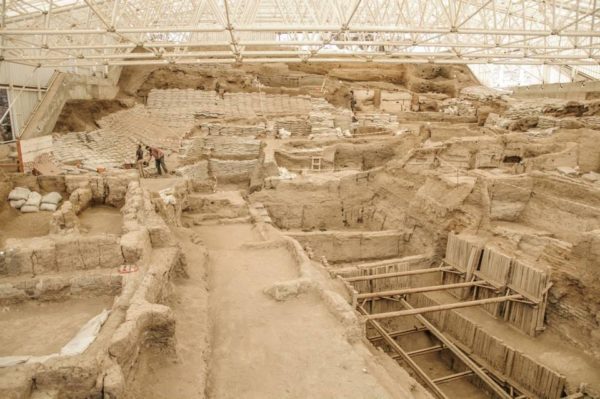
Last summer, Claudia McKenzie ’18 uncovered a 10,000 year old painting using just small dental tools.
The find came during McKenzie’s first experience with archaeology, at the Stanford Archaeology Center’s “field school” in Catalhoyuk, Turkey. Every summer, the Stanford Archaeology Center gives dozens of students of all majors hands-on experience on professional archaeology projects all around the world.
This year, participants dove into a shipwreck at the Marzamemi Maritime Heritage Project in Italy, mapped the Chavin de Huantar site dating back to 1200 B.C.E. in Perú and studied the impact of colonialism on Mauritius.
For Madeleine Ota ’18, a double major in archaeology and classics working on the Marzamemi project, the best part about archaeology is seeing how the Classical period remains relevant.
“People are so fascinated by the Classical world,” Ota said. “Even a thousand years later people want to understand how all these different cultures, ideas and concepts have come about, how they relate to the western world today.”
This year at the Marzamemi excavation site, groups alternated between hour-long dives off the coast of Sicily and artifact restoration and conservation at Rudini, a winery-turned-local museum.
According to Ota, teams found chunks of marble while diving that were once part of great columns to build an early Byzantine church. Groups also found skeletons of iron castings that had reacted with the seawater to leave rusted, hollow rock through a process known as concretion.
Meanwhile, students working at Rudini used a variety of computer programs such as Agisoft Photo Scan to recreate what their finds would have looked like in the past. Many artifacts found at sea are broken, worn down or covered in sea life, and programs like Agisoft align photos taken from different angles to bring together a coherent picture.
“To have technology as a different outlet for possibility is really cool,” Ota said. “I love to get in touch with ancient history by looking at something a lot of people traveled with in the past.”
For many students, the ability to balance the ancient and the contemporary in a single space can make a hazy past a more grounded reality worth exploring.
For Bright Zhou ’16, discovering human remains three years ago at Catalhoyuk set the foundation for the rest of his career. Zhou, who came to Stanford to study medicine, ended up majoring in archaeology and basing his senior thesis on his work at Catalhoyuk as well as his independent project at Mauritius.
Zhou believes one of archaeology’s major goals is to connect people with their country’s history. During his fieldwork in Turkey, he, too, found himself steeped in local heritage in a way that informed his present day travels.
“Between those two years I picked up so many words from the Turkish language,” Zhou said. “Then I went to Istanbul, and while admittedly many more people spoke English there, being able to make my way around, being present and being ready to learn, I definitely immersed myself in their modern culture.”
Although Stanford no longer runs the program in Turkey due to safety concerns, Catalhoyuk has already left its mark on many students. For McKenzie, the Catalhoyuk Research Project has made archaeology accessible where once it seemed wildly foreign. Uncovering paintings and thousand-year-old eggshells taught her that history can be found in the smallest things, she said.
“You aren’t just digging mindlessly,” McKenzie said. “Someone opened a burial with the body’s brain matter completely preserved. In the landfill I was digging at, the eggshells we found were the earliest evidence of bird domestication back ten thousand years ago. It shows there is something significant we are searching for.”
Contact Jessica Xing at jessica.xing1998 ‘at’ gmail.com.
